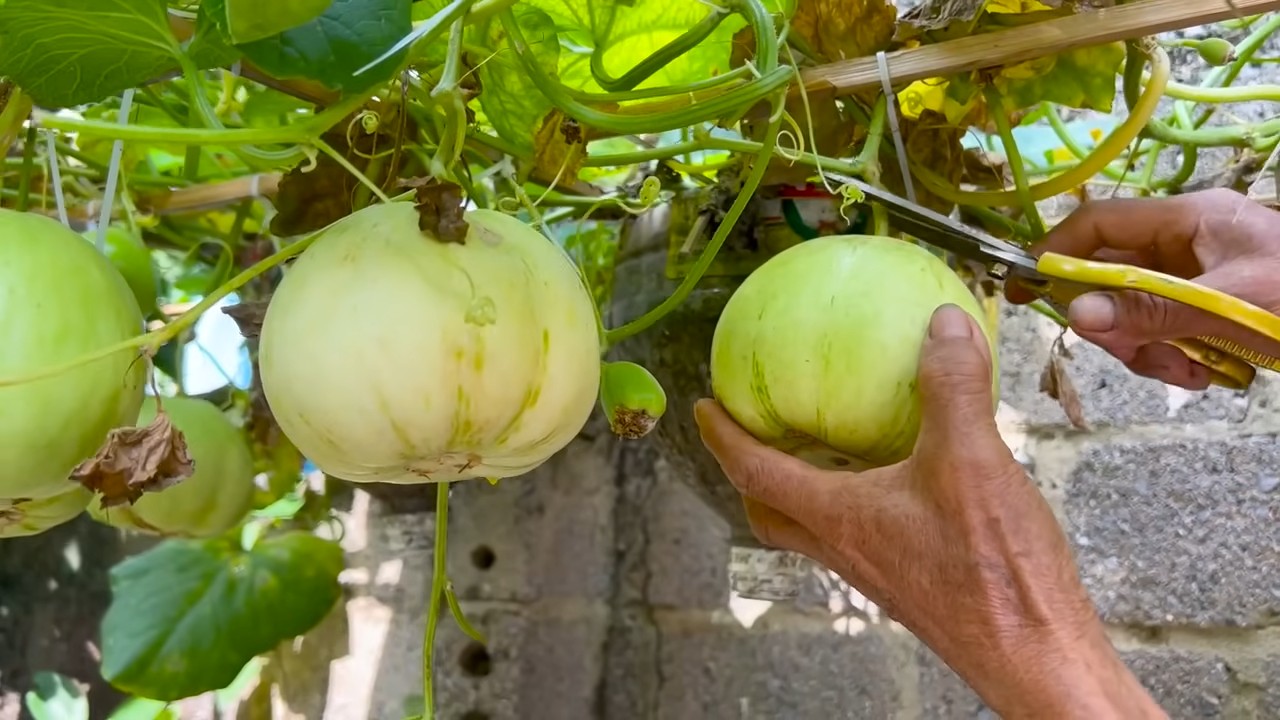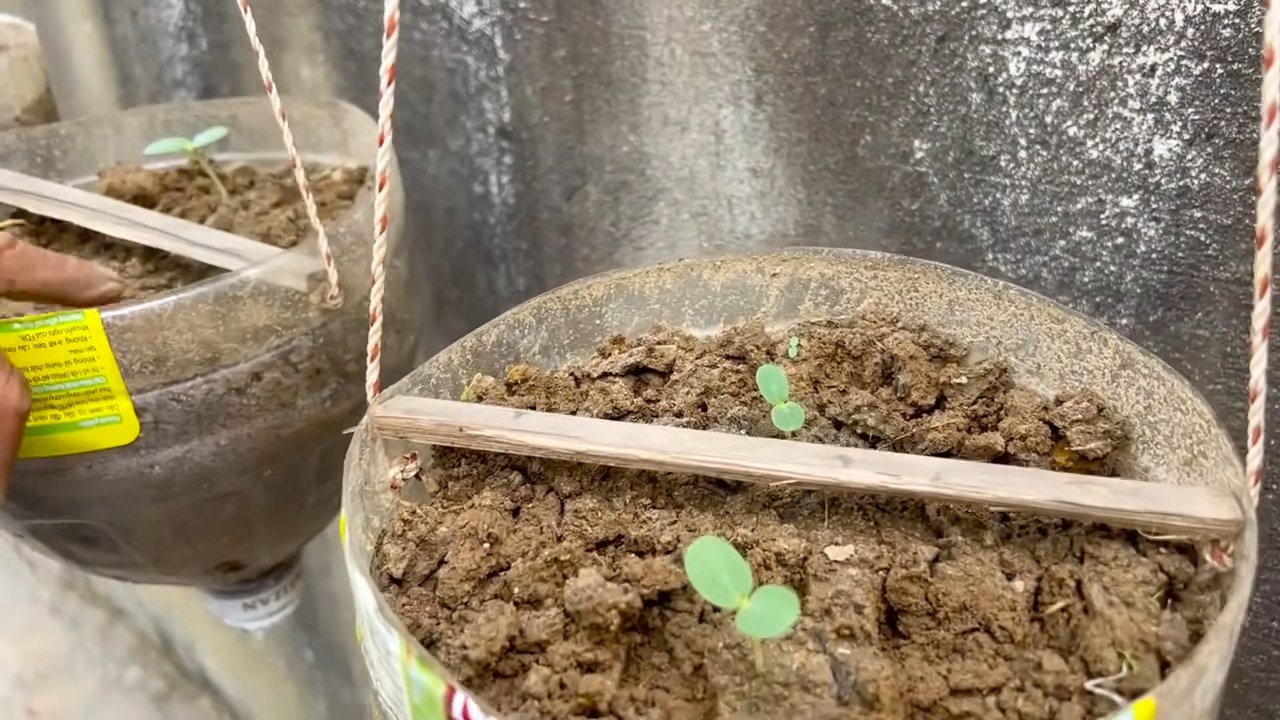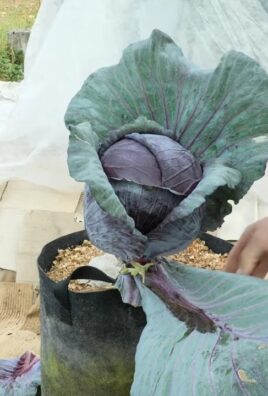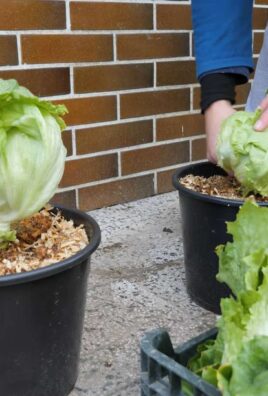Grow bigger melons than you ever thought possible! Imagine sinking your teeth into a juicy, homegrown watermelon so large it practically feeds the whole neighborhood. Sounds like a dream, right? Well, it doesn’t have to be! This isn’t just about bragging rights; it’s about maximizing your garden’s potential and enjoying the fruits (literally!) of your labor.
For centuries, gardeners have sought ways to coax the most impressive yields from their crops. From ancient Egyptians cultivating watermelons along the Nile to modern-day farmers employing cutting-edge techniques, the quest for bigger, better melons has been a constant. There’s something deeply satisfying about nurturing a tiny seed into a bountiful harvest, and I’m here to share some simple, yet effective, DIY tricks to help you achieve just that.
Let’s face it, store-bought melons can be disappointing. Often bland and lacking that intense sweetness, they simply don’t compare to the flavor explosion of a homegrown melon ripened to perfection. But getting those prize-winning sizes can seem daunting. That’s where these DIY hacks come in! I’m going to show you how to grow bigger melons using readily available materials and easy-to-follow techniques. Whether you’re a seasoned gardener or just starting out, these tips will empower you to cultivate impressive melons that will be the envy of everyone you know. Get ready to roll up your sleeves and unlock the secrets to melon-growing success!

How to Grow Melons That Are the Envy of the Neighborhood (Seriously!)
Okay, let’s talk melons. Big, juicy, sweet melons. I’m not talking about those sad, little grocery store excuses for melons. I’m talking about melons so big you need help carrying them, so sweet they drip down your chin, and so flavorful they make you forget all your troubles. Sounds good, right? Well, it’s totally achievable, even if you’re a beginner gardener. I’m going to walk you through everything I’ve learned over the years to get those prize-winning melons.
Understanding Melon Needs: The Foundation for Success
Before we dive into the nitty-gritty, let’s understand what melons crave. Think of them as sun-loving, nutrient-hungry divas. They need:
* Sun, sun, and more sun: At least 6-8 hours of direct sunlight per day. Seriously, don’t skimp on this.
* Warmth: Melons are warm-weather crops. They hate frost and chilly temperatures.
* Well-drained soil: Soggy soil is a melon’s worst enemy. It leads to root rot and other nasty problems.
* Rich soil: Melons are heavy feeders. They need plenty of nutrients to fuel their growth.
* Consistent watering: Melons need consistent moisture, especially when they’re setting fruit.
* Support (sometimes): Depending on the variety, your melons might need some support to keep them off the ground.
Choosing the Right Melon Variety: Size Matters!
Not all melons are created equal. Some varieties are naturally larger than others. If you’re aiming for those behemoth melons, choose wisely! Here are a few of my favorites:
* Watermelon:
* ‘Carolina Cross’: This is the king of giant watermelons. It can easily reach over 200 pounds!
* ‘Charleston Gray’: A classic variety known for its elongated shape and sweet, red flesh. It can get pretty big, too.
* ‘Black Diamond’: A dark green watermelon with deep red flesh. It’s not quite as large as ‘Carolina Cross,’ but it’s still impressive.
* Cantaloupe:
* ‘Athena’: A reliable cantaloupe variety that produces large, flavorful melons.
* ‘Hales Best Jumbo’: As the name suggests, this cantaloupe is known for its large size.
* Honeydew:
* ‘Honey Dew Green-O’: A large honeydew variety with sweet, green flesh.
Getting Started: Planting Your Melon Seeds or Transplants
Okay, let’s get our hands dirty! You can start melon seeds indoors or direct sow them in the garden. I prefer starting them indoors to get a head start, especially in areas with shorter growing seasons.
Starting Seeds Indoors:
1. Timing is key: Start your seeds about 4-6 weeks before the last expected frost.
2. Use seed-starting mix: Don’t use regular potting soil. Seed-starting mix is lighter and better for germination.
3. Plant in individual pots: Melons don’t like their roots disturbed, so plant each seed in its own pot (I like using peat pots or biodegradable pots).
4. Plant seeds about 1/2 inch deep: Gently press the soil down after planting.
5. Water gently: Keep the soil moist but not soggy.
6. Provide warmth: Melons need warmth to germinate. Use a heat mat or place the pots in a warm location.
7. Provide light: Once the seedlings emerge, provide them with plenty of light. A grow light is ideal, but a sunny windowsill can also work.
8. Harden off the seedlings: Before transplanting them into the garden, gradually acclimate them to outdoor conditions. This process takes about a week. Start by placing them outside for a few hours each day, gradually increasing the amount of time they spend outdoors.
Direct Sowing Seeds:
1. Wait until the soil is warm: Melons need warm soil to germinate. Wait until the soil temperature is consistently above 65°F (18°C).
2. Prepare the soil: Amend the soil with compost or well-rotted manure.
3. Plant seeds about 1 inch deep: Space the seeds according to the variety’s recommendations.
4. Water gently: Keep the soil moist but not soggy.
5. Protect from pests: Young seedlings are vulnerable to pests like slugs and snails. Use row covers or other protective measures.
Transplanting Seedlings:
1. Choose a sunny location: Remember, melons need at least 6-8 hours of direct sunlight per day.
2. Prepare the soil: Amend the soil with compost or well-rotted manure.
3. Dig a hole slightly larger than the pot: Gently remove the seedling from the pot, being careful not to disturb the roots.
4. Place the seedling in the hole: Make sure the top of the root ball is level with the surrounding soil.
5. Backfill the hole with soil: Gently press the soil down around the seedling.
6. Water thoroughly: Water the seedling well after planting.
7. Mulch around the plant: Mulch helps to retain moisture, suppress weeds, and regulate soil temperature.
Feeding Your Melons: The Secret to Size and Sweetness
Melons are heavy feeders, so you need to provide them with plenty of nutrients. I like to use a combination of organic and synthetic fertilizers.
1. Amend the soil with compost or well-rotted manure: This provides a slow-release source of nutrients.
2. Use a balanced fertilizer: Look for a fertilizer with a balanced NPK ratio (nitrogen, phosphorus, and potassium). I like to use a 10-10-10 fertilizer.
3. Side-dress with fertilizer: Side-dress your melon plants with fertilizer every 2-3 weeks. To side-dress, sprinkle the fertilizer around the base of the plant, being careful not to get it on the leaves. Water the fertilizer into the soil.
4. Foliar feed: Foliar feeding is a great way to provide your melon plants with a quick boost of nutrients. Use a liquid fertilizer and spray it directly onto the leaves.
5. Pay attention to potassium: Potassium is especially important for melon development. It helps to improve fruit size, sweetness, and flavor. You can supplement with potassium by adding wood ash to the soil or using a potassium-rich fertilizer.
Watering Your Melons: Keeping Them Hydrated
Melons need consistent moisture, especially when they’re setting fruit. However, it’s important to avoid overwatering, which can lead to root rot.
1. Water deeply and infrequently: Water your melon plants deeply, but only when the soil is dry to the touch.
2. Water in the morning: This allows the foliage to dry out during the day, which helps to prevent fungal diseases.
3. Use a soaker hose or drip irrigation: These methods deliver water directly to the roots, which helps to conserve water and prevent fungal diseases.
4. Avoid overhead watering: Overhead watering can lead to fungal diseases.
5. Reduce watering as the fruit ripens: This helps to concentrate the sugars in the fruit, making it sweeter.
Pruning and Training Your Melons: Maximizing Fruit Production
Pruning and training your melon plants can help to improve air circulation, reduce disease, and maximize fruit production.
1. Prune suckers: Suckers are small shoots that grow from the base of the plant. Remove them to encourage the plant to focus its energy on fruit production.
2. Pinch off the ends of the vines: This encourages the plant to produce more side shoots, which will produce more fruit.
3. Train the vines: Train the vines to grow in a specific direction. This helps to keep the fruit off the ground and improve air circulation.
4. Use supports: Depending on the variety, your melons might need some support to keep them off the ground. You can use trellises, slings, or even old pantyhose.
Protecting Your Melons from Pests and Diseases: Keeping Them Healthy
Melons are susceptible to a variety of pests and diseases. Here are a few common problems and how to deal with them:
* Squash bugs: These pests can damage melon vines and fruit. Handpick them off the plants or use an insecticide.
* Cucumber beetles: These pests can spread diseases and damage melon vines and fruit. Use row covers to protect young plants or use an insecticide.
* Aphids: These pests suck the sap from melon leaves. Spray

Conclusion
So, there you have it! This simple yet effective DIY trick to grow bigger melons is a game-changer for any home gardener, regardless of experience level. We’ve walked you through the process, highlighting the science behind why it works and offering practical tips to ensure your success.
Why is this a must-try? Because who doesn’t want to harvest larger, juicier, and more flavorful melons? This method isn’t just about size; it’s about optimizing the plant’s energy allocation, ensuring that the developing melons receive the nutrients they need to reach their full potential. Imagine the satisfaction of slicing into a homegrown watermelon that dwarfs anything you could find at the grocery store! Think of the delicious cantaloupe, honeydew, or other melon varieties you can cultivate, all bursting with sweetness and flavor.
But the benefits extend beyond just the impressive size. By focusing the plant’s resources on fewer fruits, you’re also improving the overall quality. This means sweeter flesh, richer color, and a more satisfying texture. Plus, you’re reducing the strain on the plant, potentially leading to a longer and more productive growing season.
Don’t be afraid to experiment with variations! While we’ve focused on a general approach, you can tailor this technique to specific melon varieties. For instance, some gardeners find that pinching off even more blossoms on smaller melon types like personal watermelons results in exceptionally sweet and concentrated flavors. Others have successfully combined this method with other techniques, such as strategic fertilization and proper watering, to achieve even more remarkable results. Consider using a diluted seaweed extract as a foliar spray to further boost nutrient uptake during fruit development. You can also try different pruning techniques to improve airflow around the plant, reducing the risk of fungal diseases.
Remember to observe your plants closely and adjust your approach as needed. Gardening is a learning process, and every season brings new opportunities to refine your skills. The key is to be patient, attentive, and willing to adapt.
We are confident that this DIY trick will significantly improve your melon-growing endeavors. It’s a simple, cost-effective, and rewarding way to maximize your harvest and enjoy the fruits (literally!) of your labor.
Now, it’s your turn! We encourage you to try this method in your own garden and share your experiences with us. Did you notice a significant difference in the size and quality of your melons? What variations did you try, and what were the results? Share your photos, tips, and stories in the comments below. We can’t wait to hear about your success stories and learn from your experiences. Let’s build a community of melon-growing enthusiasts and help each other achieve even greater harvests!
Ready to Grow Bigger Melons?
Don’t delay! Get started today and prepare to be amazed by the results. With a little effort and this simple DIY trick, you’ll be enjoying the biggest, juiciest, and most delicious melons you’ve ever grown. Happy gardening!
Frequently Asked Questions (FAQ)
Q: How many melons should I leave on each plant to grow bigger melons?
A: The ideal number depends on the melon variety and the overall health of your plant. For larger varieties like watermelons, it’s generally recommended to leave only 1-2 melons per plant. For smaller varieties like cantaloupe or honeydew, you might be able to leave 2-3. Observe your plant closely. If the remaining melons are growing slowly or the plant appears stressed, consider removing additional melons.
Q: When should I start pinching off blossoms to grow bigger melons?
A: Start pinching off blossoms once the plant has set a few fruits. Typically, this is when the melons are about the size of a golf ball or tennis ball. Focus on removing any new blossoms that appear after the initial fruits have started to develop. This ensures that the plant’s energy is directed towards the existing melons.
Q: What if I accidentally remove too many blossoms?
A: Don’t worry! Melon plants are resilient. If you accidentally remove too many blossoms, the plant will likely produce more. Just be sure to monitor the plant and remove any excess blossoms once the desired number of fruits has set.
Q: Will this trick work for all types of melons?
A: Yes, this trick can be applied to most types of melons, including watermelons, cantaloupe, honeydew, and even smaller varieties like personal watermelons. However, the number of melons you leave on each plant may vary depending on the variety.
Q: What other factors contribute to growing bigger melons?
A: While pinching off blossoms is a crucial step, other factors also play a significant role. These include:
* **Soil quality:** Melons need well-drained soil rich in organic matter. Amend your soil with compost or aged manure before planting.
* **Watering:** Melons need consistent watering, especially during fruit development. Water deeply and regularly, but avoid overwatering, which can lead to root rot.
* **Fertilization:** Melons are heavy feeders and benefit from regular fertilization. Use a balanced fertilizer or one specifically formulated for fruits and vegetables.
* **Sunlight:** Melons need at least 6-8 hours of sunlight per day.
* **Pest and disease control:** Monitor your plants regularly for pests and diseases and take appropriate action to prevent or control them.
Q: Can I use this trick in containers?
A: Yes, you can use this trick in containers, but it’s even more important to limit the number of melons per plant, as container-grown plants have limited resources. Choose a large container (at least 20 gallons) and use a high-quality potting mix.
Q: How do I know when my melons are ripe?
A: The signs of ripeness vary depending on the melon variety. Some general indicators include:
* **Color change:** The skin of the melon may change color as it ripens.
* **Stem separation:** The stem may start to separate easily from the melon.
* **Sound:** When tapped, a ripe melon may sound hollow.
* **Aroma:** A ripe melon may have a sweet aroma.
Research the specific signs of ripeness for the melon variety you are growing.
Q: Is there anything else I can do to improve the flavor of my melons?
A: Yes! In addition to the tips mentioned above, consider these:
* **Reduce watering before harvest:** Reducing watering a week or two before harvest can concentrate the sugars in the melon, resulting in a sweeter flavor.
* **Protect from pests:** Pests can damage melons and affect their flavor. Use appropriate pest control methods to protect your plants.
* **Harvest at the right time:** Harvesting melons at the peak of ripeness is crucial for optimal flavor.
Q: What if my melons are still small even after trying this trick?
A: Several factors could be contributing to small melons. Double-check that you are providing adequate water, nutrients, and sunlight. Also, consider the variety of melon you are growing. Some varieties are naturally smaller than others. If you’ve addressed all these factors and your melons are still small, it’s possible that there are underlying soil issues or diseases affecting your plants. Consider getting your soil tested to identify any nutrient deficiencies or imbalances.
Q: Can I use this method for other fruiting plants, like pumpkins or squash?
A: Yes, the principle of focusing the plant’s energy on fewer fruits can be applied to other fruiting plants like pumpkins, squash, and even tomatoes. The specific number of fruits to leave on each plant will vary depending on the variety and the desired size of the fruit. Experiment and observe your plants to find what works best for you.




Leave a Comment